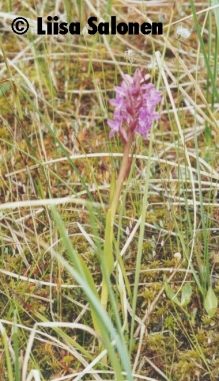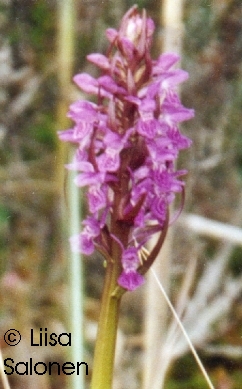
 Dactylorhiza
sphagnicola, luhtakämmekkä
Dactylorhiza
sphagnicola, luhtakämmekkä
D sphagnicola belongs to the relatives of D. incarnata and D. traunsteineri, and it is not easy to tell it apart from D. incarnata. Plants looking like D. sphagnicola also be some hybrids of this genus. If one thinks that he or she has found this plant, all the structures of the plants must be right and the bog where the plant grows must als
 o
be suitable for the species to grow. There should also be no other Dactylorhizas
nearby, as that would success that the plant found would be a hybrid. Some
people are not ready to gie D. sphagnicola a value of species.
o
be suitable for the species to grow. There should also be no other Dactylorhizas
nearby, as that would success that the plant found would be a hybrid. Some
people are not ready to gie D. sphagnicola a value of species.
The plant is weak when compared to D. incarnata but the stem is clearly thicker than one of D. traunsteineri. It has tight inflorescense, but the flowering is not as shhowy as D. incarnata has. The greatest different between these two speies is between the markings of the flowers.: D. sphagnicola usually has only spots or very light stripes on the lip, while D. incarnata has almost always some striped, too. The shape of the lip is also little different, D. sphagnicola seems to have little larger flowers, as the edges of the lip are not strongly curved backwards as in D. incarnata´s case. D. sphagnicola also has more narrow leaves (in D. incarnata 5-9 times longer than theyre wight, in D. sphagnicola 1o-15 times). The leaves have no spots in neither of the species. D. sphagnicola does not stand lime and alkaline earth, while D. incarnata always grows in limey bogs with lot of nutriense.
But unfortunately both species vary a lot, and the ways abowe are not alway good when we are trying to tell these plants apart. That is why it is so important that all those things are true before we can say that we are talking about D. sphagnicola. And besides all the things said, the "D. sphagnicolas" in the same bog should not vary too much - that is a proof of hybridizing.
Because of all this, no-one can say for sure wethe this species grows i Finland. According to Retkeilykasvio (Finnish flora) this species "propably grows in Ahvevnanmaa and southern Finland". I have different picture of the possible occuring of this plant, as all the "D. sphagnicola"-findings I know have been made from eastern Finland Over there also both D. incarnata and D. traunsteineri are more common than in other parts of the country. For now I can say nothing about the possible growing-places of this species. Some people say that this species does not grow in Finland, but I claim something else - for now.
 This
summer, in our wisit to the orchid-areas of Lappeenranta Liisa showed me
a photo of Dactylorhiza incarnatas she had taken in Savonlinna. She had
been in the place after she had heard that there grows two orchids. With
some searching she did find some Corallorhiza trifidas and finally
also those Dactylorhizas (this is proof number one - no other Dactylorhiza-species
around). She took some photos from the place and showed them to us others
in Lappeenranta. Right after seeing the pics I got an idea: could it be
sphagnicola?? Closer look made this plant really look like D.
sphagnicola. Later on I heard that there should only be spots in the
lip, no lines. The flower had very thin lines, but it theyre not whole
(look ate the photo below, this is proof number two, the plant looks almost
exactly like D. sphagnicola). As there also grows Hammarbya paludosa
(species Liisa found later on) and Corallorhiza in this place, the
ground cannot be too limey, also the Callunas in the photos speak
for the same thing (this is proof number three). What things make me to
susbect this finding? At first, I have too few pictures to study, and the
markings of the lip is not exactly c
This
summer, in our wisit to the orchid-areas of Lappeenranta Liisa showed me
a photo of Dactylorhiza incarnatas she had taken in Savonlinna. She had
been in the place after she had heard that there grows two orchids. With
some searching she did find some Corallorhiza trifidas and finally
also those Dactylorhizas (this is proof number one - no other Dactylorhiza-species
around). She took some photos from the place and showed them to us others
in Lappeenranta. Right after seeing the pics I got an idea: could it be
sphagnicola?? Closer look made this plant really look like D.
sphagnicola. Later on I heard that there should only be spots in the
lip, no lines. The flower had very thin lines, but it theyre not whole
(look ate the photo below, this is proof number two, the plant looks almost
exactly like D. sphagnicola). As there also grows Hammarbya paludosa
(species Liisa found later on) and Corallorhiza in this place, the
ground cannot be too limey, also the Callunas in the photos speak
for the same thing (this is proof number three). What things make me to
susbect this finding? At first, I have too few pictures to study, and the
markings of the lip is not exactly c lear.
Second, the thin lines on the lip bothers me. And the third thing is that
I cannot be sure that the area is really limey, as I have not asked it
well enough from Liisa.
lear.
Second, the thin lines on the lip bothers me. And the third thing is that
I cannot be sure that the area is really limey, as I have not asked it
well enough from Liisa.
I will try to go to that place next summer and make some "studies",
if I´ll have time.